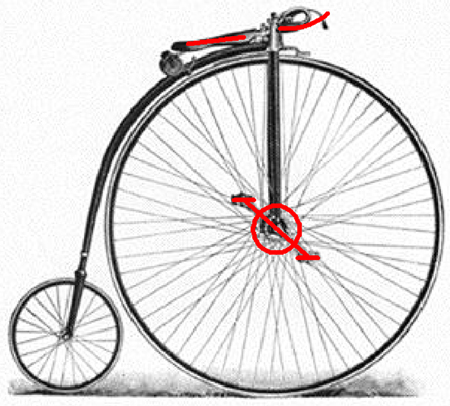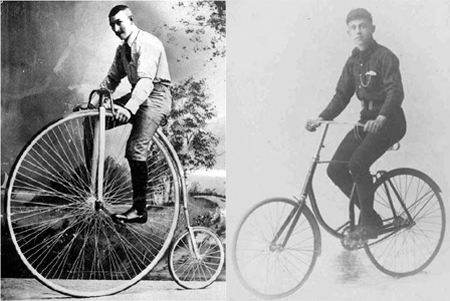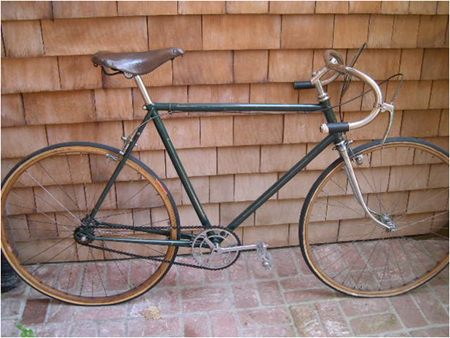Old bike designs die hard
 Fri, June 5, 2009
Fri, June 5, 2009  In my previous post I wrote how the High-wheeler or Ordinary bike influenced riding habits well into the next century. It also influenced frame design into the 1950s and 1960s.
In my previous post I wrote how the High-wheeler or Ordinary bike influenced riding habits well into the next century. It also influenced frame design into the 1950s and 1960s.
If you look at the top picture you can see, due to the simplistic design of these old bikes, there was a limitation where the rider could be placed. I have drawn in red the three points of contact; the saddle, pedals, and handlebars.
With the steering almost vertical, the handlebars are directly above the pedals. If you can imagine on a modern bike if the handlebars were directly above the bottom bracket, they would be about where the nose of your saddle is.
So you can appreciate that if this were the situation, the rider would have to sit much further back. This was the case on the old ordinary bikes the riders were sitting much further back than we do today.
People do not like change, and as I mentioned in my last piece the cycling enthusiast did not take to the new fangled “Safety” bicycle immediately. It was necessary for those designing the new machine to place the rider in a position he was familiar with.
In the next picture I have drawn a safety bicycle superimposed on the ordinary. I left the saddle, pedals, and handlebars exactly where they were on the high-wheeler. By placing a front and rear wheels in the only logical place, and connecting all the dots, you can see we have a close approximation of a early safety bicycle.

This theory is confirmed by the photos below, showing two riders in almost identical positions; one on an ordinary and one on a “Rover,” the first safety bike.

The next picture below is of Ottavio Bottecchia's bike; an Automoto that he rode to victory in the 1925 Tour de France. In 25 or 30 years the handlebars have been moved forward and lowered, but the saddle position in relation to the pedals has remained as it was on the ordinary. The seat angle is about 68 degrees.

The picture below is of Louison Bobet’s French made Stella that he rode to his 1954 Tour de France win. The angles have become slightly steeper and the fork rake is shortened. However, look at where the nose of the saddle is in relation to the bottom bracket.

This was the way bikes were designed when I started racing in 1952. I was always told by my elders that I had to sit back in order to pedal efficiently. In time I questioned this because I am somewhat short in stature, and found when making maximum effort, I would slide forward and end up sitting on the nose of the saddle.
Studying photos of other riders I could see many had the same problem, this is what started me experimenting with frame design. Initially I was just looking to improve my own performance.
The problem has always been that in general, people who race bikes do not build them, and people who build bikes do not race them. And no one ever questions why certain aspects of design are the way they are.
 Dave Moulton | Comments Off |
Dave Moulton | Comments Off | 
















Reader Comments (7)
Another great post, thanks Dave! I'm struck by the similarlity between Ottavio Bottecchia's bike and this picture of a trendy courier style-bike, currently in fashion here in Bristol UK.
Hi Dave,
I really like how well thought out your blog posts are. I have a question about this distance from saddle nose to bottom bracket. I've got pretty long legs and torso (i'm 6'5) and I actually discovered that I can pedal easier at higher cadences with the saddle further back. However every other rider(generally much shorter than me) claims that moving the saddle position from the supposedly ideal one(ie the default) further back will have some negative impact.
Do you think the modern practice of having an almost identical seat-tube angle for all frames sizes(ie they usually differ by less than .5 degrees) results in an optimal saddle position for tall people? My own experience suggests otherwise, but does that hold for other tall(or short?) riders?
So, Dave, you were riding "on the rivet"!
How very true! At 5'6", I'm usually compromising between sitting back and "pedaling efficiently," and sliding forward a little to "reach the handlebars." I only need an inch or so, but I can't move the seat forward any more. And I don't really want the handlebars any further back; a moderate forward lean seems necessary too. I had the same problem with motorcycles. I guess everything is designed for an average height a little above mine. I enjoy your blog. You have a unique perspective and good common-sense outlook.
Just for the extra challenge I will take a track bike out on the road. It has a road fork, and because of my spouse and sanity, a front brake. To spin a bit better which happens because of the 165 cranks, I use a slightly lower seat position. That said, I am always amazed by the riders on super-aero carbon fiber bikes who coast, wimp out on hills, and do not bother to downshift. On a track bike, you learn to sprint the hills and downshifts are not possible, all you can do is pedal. What you quickly realize when you are constantly pedaling is that the aero advantage is very small and one fluffed hill negates those extra thousands. Just pedaling, all the time, really helps getting you there faster. Too, many riders with aero bars "forget" to pedal when they start to get off-line. The missed strokes, especially on the flat completely wipe out the aero advantage. Position is part of the "game" but not everything.
Fascinatng stuff Dave.
And those who do ride and design are promptly banned by the UCI!